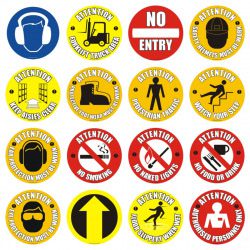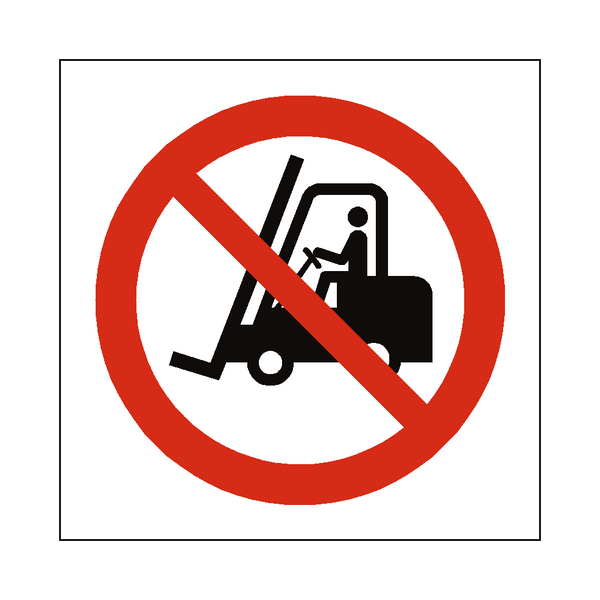Forklift Signs-- Rise Safety Recognition in High-Traffic Locations
Forklift Signs-- Rise Safety Recognition in High-Traffic Locations
Blog Article
Trick Factors To Consider for Creating Effective Forklift Safety And Security Indications
When developing effective forklift safety and security indicators, it is vital to take into consideration a number of fundamental variables that collectively make certain optimal visibility and quality. High-contrast colors coupled with huge, legible sans-serif typefaces substantially boost readability, specifically in high-traffic locations where fast understanding is vital. forklift signs. Strategic placement at eye degree and using sturdy materials like aluminum or polycarbonate more contribute to the durability and effectiveness of these signs. Adherence to OSHA and ANSI guidelines not only standardizes security messages but also boosts conformity. To totally realize the intricacies and finest techniques included, several added considerations advantage closer interest.
Shade and Comparison
While making forklift safety and security indicators, the choice of color and comparison is critical to guaranteeing presence and performance. The Occupational Safety and Health And Wellness Management (OSHA) and the American National Specification Institute (ANSI) provide standards for utilizing colors in security indicators to systematize their significances.
Efficient contrast between the history and the text or signs on the sign is similarly important (forklift signs). High comparison guarantees that the indicator is understandable from a distance and in varying illumination conditions.
Using appropriate shade and comparison not just complies with regulatory requirements yet also plays a vital role in preserving a risk-free functioning environment by making certain clear interaction of hazards and instructions.

Font Dimension and Style
When developing forklift security indications, the choice of font size and design is essential for ensuring that the messages are understandable and promptly comprehended. The primary purpose is to boost readability, specifically in settings where fast details handling is vital. The font dimension must be large sufficient to be read from a range, accommodating differing sight problems and making sure that workers can comprehend the sign without unneeded pressure.
A sans-serif font is normally advised for safety signs as a result of its clean and uncomplicated appearance, which boosts readability. Font styles such as Arial, Helvetica, or Verdana are often favored as they lack the complex information that can cover critical information. Uniformity in font style across all safety indications aids in developing an attire and specialist appearance, which further strengthens the value of the messages being communicated.
In addition, emphasis can be attained through tactical usage of bolding and capitalization. By carefully selecting proper typeface dimensions and styles, forklift safety and security indicators can efficiently communicate vital safety information to all workers.
Placement and Visibility
Guaranteeing ideal positioning and exposure of forklift security signs is paramount in commercial setups. Appropriate indication placement can dramatically minimize the danger of crashes and improve overall office safety.

Indicators need to be well-lit or made from reflective materials in dimly lit areas to guarantee they are noticeable at all times. By carefully taking into consideration these facets, one can ensure that forklift security signs are both effective and noticeable, consequently cultivating a safer working atmosphere.
Material and Toughness
Choosing the right products for forklift safety and security indicators is critical to ensuring their longevity and effectiveness in industrial environments. Given the severe problems commonly run into in warehouses and manufacturing facilities, the materials chosen have to endure a selection of stressors, including temperature level fluctuations, moisture, chemical exposure, and physical impacts. Resilient substrates such as light weight aluminum, high-density polyethylene (HDPE), and polycarbonate are popular options due to their resistance to these elements.
Light weight aluminum is renowned for its effectiveness and deterioration resistance, making it a superb selection for both interior and outside applications. HDPE, on the other hand, offers phenomenal effect resistance and can endure prolonged exposure to rough chemicals without degrading. Polycarbonate, recognized for its high effect stamina and quality, is usually utilized where visibility and durability are paramount.
Similarly crucial is the type of printing utilized on the indications. UV-resistant inks and safety finishes can substantially boost the life expectancy of the signage by protecting against fading and wear triggered by extended direct exposure to sunlight and other ecological factors. Laminated or screen-printed surfaces give additional layers of security, ensuring that the vital safety and security details continues to be readable gradually.
Purchasing top quality materials and durable production processes not just expands the life of forklift security indications but likewise enhances a society of security within the workplace.
Conformity With Laws
Sticking to regulatory requirements is read more extremely important in the design and deployment of forklift security indicators. Compliance guarantees that the indications are not just effective in conveying critical safety and security information yet also fulfill legal responsibilities, thus alleviating prospective obligations. Different companies, such as the Occupational Security and Health And Wellness Management (OSHA) in the United States, offer clear guidelines on the requirements of security indicators, including color design, message dimension, and the addition of universally acknowledged icons.
To abide by these regulations, it is vital to perform an extensive testimonial of applicable criteria. OSHA mandates that security signs must be noticeable from a range and include particular shades: red for risk, yellow for caution, and green for safety directions. Additionally, sticking to the American National Criteria Institute (ANSI) Z535 series can better more improve the efficiency of the signs by standardizing the layout aspects.
In addition, normal audits and updates of security indicators need to be performed to ensure recurring conformity with any type of modifications in guidelines. Involving with licensed security specialists during the layout stage can also be valuable in making sure that all regulatory requirements are met, and that the indicators serve their intended purpose effectively.
Conclusion
Designing efficient forklift security indicators requires careful interest to shade comparison, typeface size, and style to guarantee ideal presence and readability. Adherence to OSHA and ANSI standards systematizes safety messages, and integrating reflective products boosts presence in low-light scenarios.
Report this page